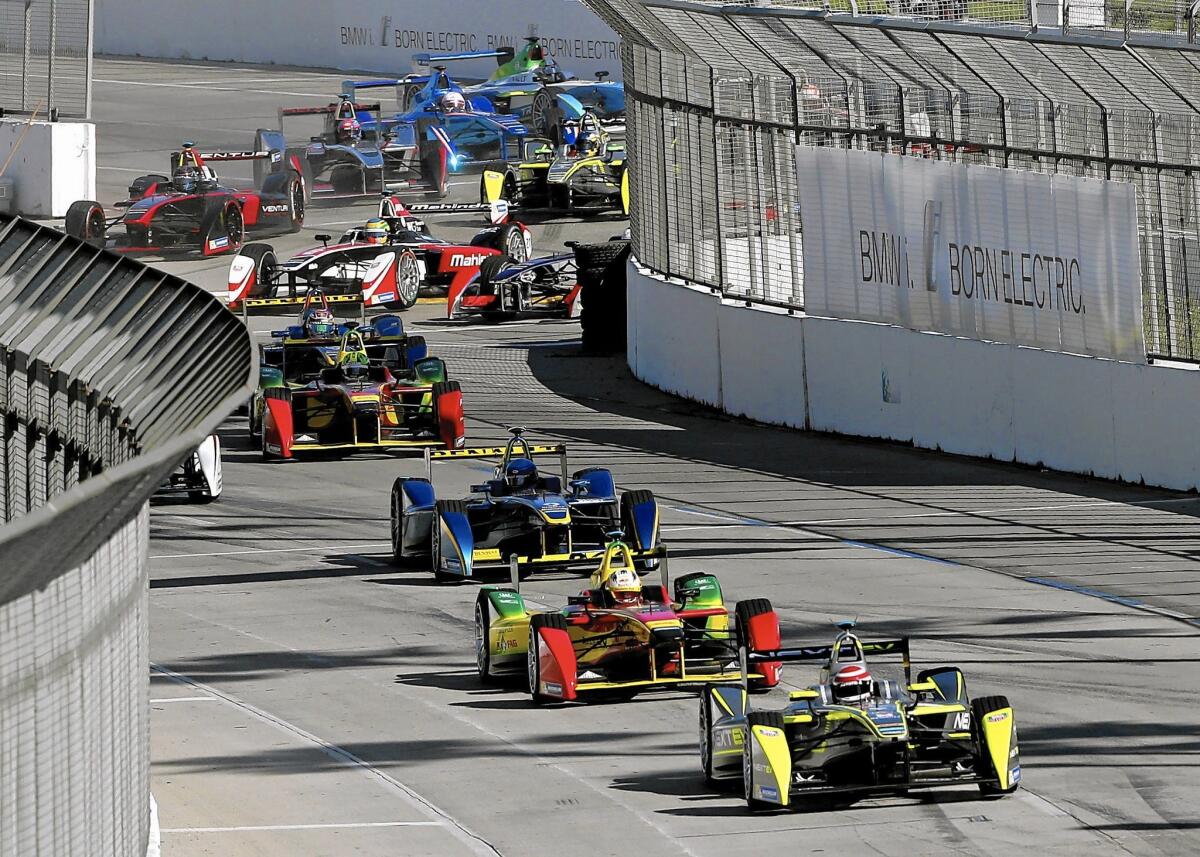Charged up over Formula E in Long Beach

Nelson Piquet Jr. of Brazil leads the pack at the start of last year’s inaugural Formula E race in Long Beach, which he won. Many spectators were surprised at how relatively quiet the cars were.
- Share via
The Formula E electric cars that will race in Long Beach on Saturday are oddly silent for racing machines, but the event rings loudly for California’s fledgling electric-car industry.
The race is a showcase for advancements in electric-car technology. And that’s why Faraday Future, an electric-car start-up based in Gardena, signed on as the race’s title sponsor and why other electric-vehicle companies are sponsoring Formula E as well.
The race caps a big weekend in Southern California for electric cars. Industry leader Tesla Motors Inc. unveiled its latest production car, the Model 3, in Hawthorne on Thursday night. Earlier in the day, thousands of potential customers lined up at Tesla’s showrooms for a chance to put down a $1,000 deposit on the car, which starts at $35,000.
Now in its second season, Formula E holds 10 races around the world featuring electric-powered cars. Its lone U.S. stop is in Long Beach, where the drivers race on part of the same street course that will be used for the iconic Toyota Grand Prix of Long Beach on April 17.
The race “is a good medium to reach out to people” about electric vehicles, which so far account for 3% or less of U.S. new-car sales, said Nick Sampson, Faraday’s senior vice president of R&D and engineering.
“Part of growing that market is increasing people’s awareness about electric cars and changing people’s perceptions,” he said. “Many people think of electric cars as being dull and boring, and that mold needs breaking.”
Indeed, Formula E cars are not go-karts; they’re bona fide race cars piloted by experienced drivers.
The series is sanctioned by the FIA, the same body that sanctions the famed Formula One racing series.
The Formula E drivers include Nelson Piquet Jr., who won the inaugural Formula E race in Long Beach last year, and Mike Conway, a two-time winner of the Toyota Grand Prix of Long Beach, one of the top races in the Verizon IndyCar Series.
For Faraday, the race also allows fans to get a close-up view of the company’s concept car, the exotic-looking FFZER01, which will be on display, and to talk to Faraday employees about the company’s plans.
Faraday — named after Michael Faraday, a British scientist known for electromagnetic discoveries in the 1800s — has about 600 employees developing the company’s first production car, which Faraday hopes to roll out within the next two years.
The car will be an upscale model in the same market niche as Tesla’s Model S sedan “with a plan to follow on with a range of vehicles” at different price points, Sampson said.
In doing so, Faraday would rival Tesla, whose Model 3 is intended for the masses with a price about half that of the $70,000 Model S. Tesla also is starting to sell the Model X sport utility vehicle.
Faraday announced in December that it would build a $1-billion production factory in Nevada that eventually would employ 4,500 people. The company expects to break ground on the plant sometime this year, Faraday spokeswoman Stacy Morris said.
In the meantime, the Formula E race in Long Beach gets people “thinking electric cars are cool and gets them familiar with the technology,” said Michael Boehm, executive director of the Advanced Transportation Center of Southern California.
The ATC, an arm of the Los Angeles County Economic Development Corp., works with companies to promote growth in the electric-vehicle industry. The race “heightens awareness” of the industry by showing high-performance electric cars, Boehm said.
At least year’s inaugural Formula E race in Long Beach, many spectators had the same reaction the first time they watched the cars speed by: They would turn to each other with a look of surprise as they heard the cars’ whooshing sound rather than the conventional roar of internal-combustion engines.
“Formula E also is quite good for our region because it helps to put Los Angeles on the map as an early adopter” of electric technology, Boehm said.
“We want to attract companies to participate in that market, and this race is a great showcase for that,” he said. “It’s not just about powering golf carts anymore.”
Twitter: @PeltzLATimes
More to Read
Inside the business of entertainment
The Wide Shot brings you news, analysis and insights on everything from streaming wars to production — and what it all means for the future.
You may occasionally receive promotional content from the Los Angeles Times.











